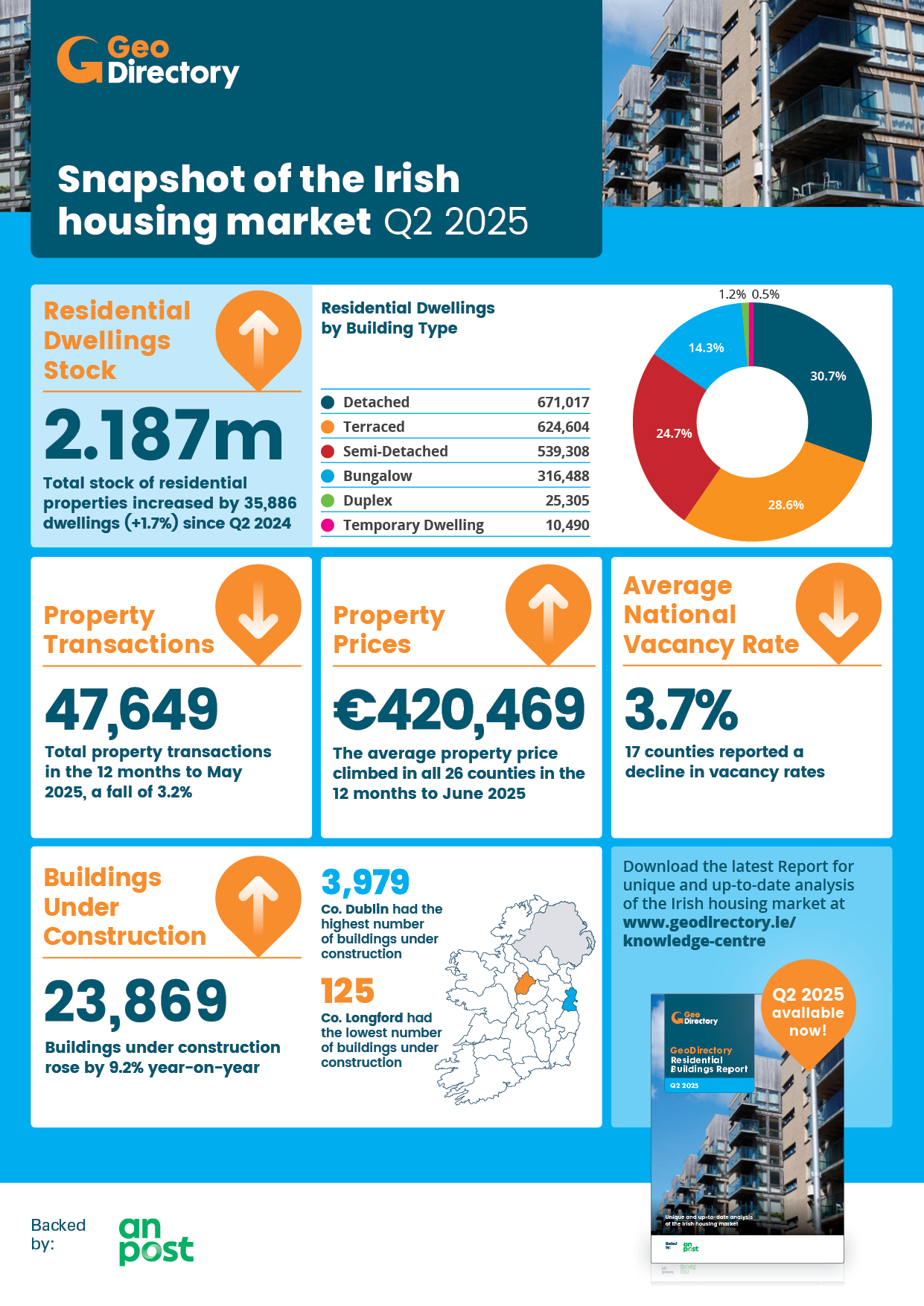[Infographic] Irish Housing Market Snapshot Q2 2025
Ireland’s residential property landscape continues to evolve, and the latest GeoDirectory Residential Buildings Report for Q2 2025 offers a compelling snapshot of the trends shaping the market. Here are the standout findings from our latests report:

Residential Stock on the Rise
The total stock of residential dwellings reached 2.187 million, marking a 1.7% increase (35,886 new dwellings) since Q2 2024. This growth reflects ongoing efforts to meet housing demand across the country.
Property Prices Climb Nationwide
The average property price now stands at €420,469, with all 26 counties reporting price increases over the past 12 months. This upward trend underscores the continued pressure on affordability and demand.
Transactions Dip Slightly
Despite rising prices, property transactions fell by 3.2%, totaling 47,649 in the 12 months to May 2025. This dip may signal market hesitation or supply constraints.
Construction Activity Accelerates
There are currently 23,869 buildings under construction, a 9.2% year-on-year increase. Notably, Dublin leads with 3,979 active sites, while Longford reports the lowest at 125.
Building Types Breakdown
Ireland’s housing stock is diverse:
Detached: 671,017
Terraced: 624,604
Semi-Detached: 539,308
Bungalow: 316,488
Duplex: 25,305
Temporary Dwellings: 10,490
This mix reflects both urban and rural housing preferences, with detached homes making up the largest share.
Vacancy Rates Improve
The national average vacancy rate is 3.7%, with 17 counties showing a decline. This is a positive sign for housing availability and occupancy.
These figures offer valuable insights for policymakers, developers, and anyone interested in Ireland’s housing future. With rising prices, active construction, and shifting vacancy rates, the market remains dynamic and complex.
For a deeper dive, download the full Q2 2025 Residential Buildings report here

Residential Stock on the Rise
The total stock of residential dwellings reached 2.187 million, marking a 1.7% increase (35,886 new dwellings) since Q2 2024. This growth reflects ongoing efforts to meet housing demand across the country.
Property Prices Climb Nationwide
The average property price now stands at €420,469, with all 26 counties reporting price increases over the past 12 months. This upward trend underscores the continued pressure on affordability and demand.
Transactions Dip Slightly
Despite rising prices, property transactions fell by 3.2%, totaling 47,649 in the 12 months to May 2025. This dip may signal market hesitation or supply constraints.
Construction Activity Accelerates
There are currently 23,869 buildings under construction, a 9.2% year-on-year increase. Notably, Dublin leads with 3,979 active sites, while Longford reports the lowest at 125.
Building Types Breakdown
Ireland’s housing stock is diverse:
Detached: 671,017
Terraced: 624,604
Semi-Detached: 539,308
Bungalow: 316,488
Duplex: 25,305
Temporary Dwellings: 10,490
This mix reflects both urban and rural housing preferences, with detached homes making up the largest share.
Vacancy Rates Improve
The national average vacancy rate is 3.7%, with 17 counties showing a decline. This is a positive sign for housing availability and occupancy.
These figures offer valuable insights for policymakers, developers, and anyone interested in Ireland’s housing future. With rising prices, active construction, and shifting vacancy rates, the market remains dynamic and complex.
For a deeper dive, download the full Q2 2025 Residential Buildings report here
Posted: 18/09/2025 09:46:21